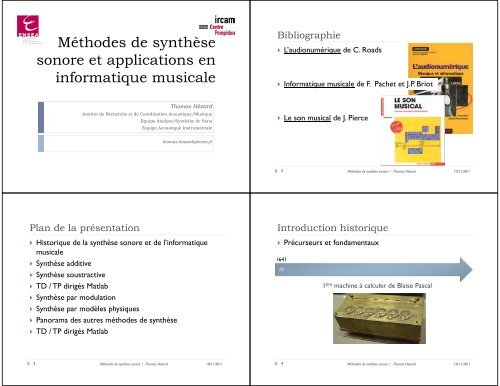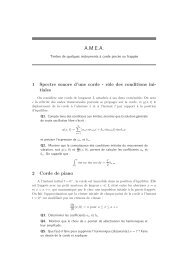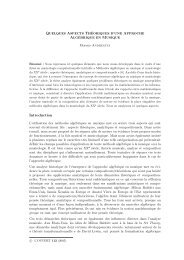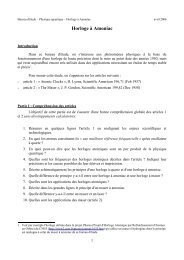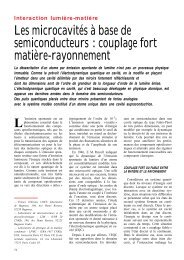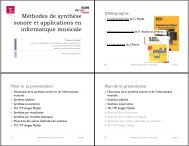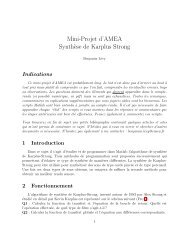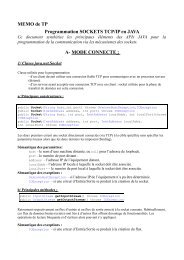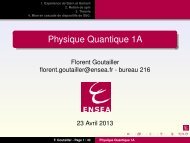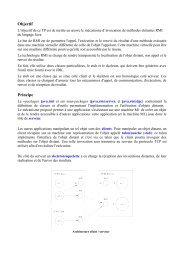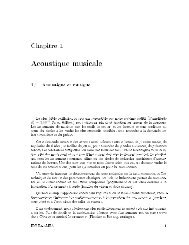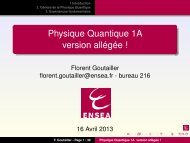Méthodes de synthèse sonore et applications en informatique ...
Méthodes de synthèse sonore et applications en informatique ...
Méthodes de synthèse sonore et applications en informatique ...
You also want an ePaper? Increase the reach of your titles
YUMPU automatically turns print PDFs into web optimized ePapers that Google loves.
<strong>Métho<strong>de</strong>s</strong> <strong>de</strong> <strong>synthèse</strong><strong>sonore</strong> <strong>et</strong> <strong>applications</strong> <strong>en</strong><strong>informatique</strong> musicaleBibliographie L’audionumérique <strong>de</strong> C. Roads Informatique musicale <strong>de</strong> F. Pach<strong>et</strong> <strong>et</strong> J.P. BriotThomas HézardInstitut <strong>de</strong> Recherche <strong>et</strong> <strong>de</strong> Coordination Acoustique/MusiqueEquipe Analyse/Synthèse <strong>de</strong> SonsEquipe Acoustique Instrum<strong>en</strong>tale Le son musical <strong>de</strong> J. Pierc<strong>et</strong>homas.hezard@ircam.fr2 <strong>Métho<strong>de</strong>s</strong> <strong>de</strong> <strong>synthèse</strong> <strong>sonore</strong> 1 - Thomas Hézard 10/11/2011Plan <strong>de</strong> la prés<strong>en</strong>tation Historique <strong>de</strong> la <strong>synthèse</strong> <strong>sonore</strong> <strong>et</strong> <strong>de</strong> l’<strong>informatique</strong>musicale Synthèse additive Synthèse soustractive TD / TP dirigés Matlab Synthèse par modulation Synthèse par modèles physiques Panorama <strong>de</strong>s autres métho<strong>de</strong>s <strong>de</strong> <strong>synthèse</strong> TD / TP dirigés MatlabIntroduction historique Précurseurs <strong>et</strong> fondam<strong>en</strong>taux16411 ère machine à calculer <strong>de</strong> Blaise Pascal3 <strong>Métho<strong>de</strong>s</strong> <strong>de</strong> <strong>synthèse</strong> <strong>sonore</strong> 1 - Thomas Hézard 10/11/20114 <strong>Métho<strong>de</strong>s</strong> <strong>de</strong> <strong>synthèse</strong> <strong>sonore</strong> 1 - Thomas Hézard 10/11/2011
Introduction historique Précurseurs <strong>et</strong> fondam<strong>en</strong>taux1751Introduction historique Précurseurs <strong>et</strong> fondam<strong>en</strong>taux1789Inv<strong>en</strong>tion <strong>de</strong> l’électricité par B<strong>en</strong>jamin FranklinPublication du mémoire <strong>de</strong> Joseph Fourier5 <strong>Métho<strong>de</strong>s</strong> <strong>de</strong> <strong>synthèse</strong> <strong>sonore</strong> 1 - Thomas Hézard 10/11/20116 <strong>Métho<strong>de</strong>s</strong> <strong>de</strong> <strong>synthèse</strong> <strong>sonore</strong> 1 - Thomas Hézard 10/11/2011Introduction historique Précurseurs <strong>et</strong> fondam<strong>en</strong>taux1821Introduction historique Précurseurs <strong>et</strong> fondam<strong>en</strong>taux1863Charles Babbage <strong>et</strong> Ada Lovelace prés<strong>en</strong>t<strong>en</strong>t la« machine à différ<strong>en</strong>ce »Publication du traité <strong>de</strong> Hermann von Helmholtz7 <strong>Métho<strong>de</strong>s</strong> <strong>de</strong> <strong>synthèse</strong> <strong>sonore</strong> 1 - Thomas Hézard 10/11/20118 <strong>Métho<strong>de</strong>s</strong> <strong>de</strong> <strong>synthèse</strong> <strong>sonore</strong> 1 - Thomas Hézard 10/11/2011
Introduction historique Précurseurs <strong>et</strong> fondam<strong>en</strong>tauxIntroduction historique Précurseurs <strong>et</strong> fondam<strong>en</strong>taux18771937Emile Berliner inv<strong>en</strong>te le premier microphoneMachine <strong>de</strong> Turing9 <strong>Métho<strong>de</strong>s</strong> <strong>de</strong> <strong>synthèse</strong> <strong>sonore</strong> 1 - Thomas Hézard 10/11/201110 <strong>Métho<strong>de</strong>s</strong> <strong>de</strong> <strong>synthèse</strong> <strong>sonore</strong> 1 - Thomas Hézard 10/11/2011Introduction historique Précurseurs <strong>et</strong> fondam<strong>en</strong>taux1944Introduction historique Précurseurs <strong>et</strong> fondam<strong>en</strong>taux1946/1947Mark-1, le premier ordinateur numérique (Harvard)Inv<strong>en</strong>tion du sonogramme11 <strong>Métho<strong>de</strong>s</strong> <strong>de</strong> <strong>synthèse</strong> <strong>sonore</strong> 1 - Thomas Hézard 10/11/201112 <strong>Métho<strong>de</strong>s</strong> <strong>de</strong> <strong>synthèse</strong> <strong>sonore</strong> 1 - Thomas Hézard 10/11/2011
Introduction historique Précurseurs <strong>et</strong> fondam<strong>en</strong>tauxIntroduction historique Premières expéri<strong>en</strong>ces <strong>et</strong> premières fondations19471917-1918Premier transistorThérémin <strong>et</strong> On<strong>de</strong>s Mart<strong>en</strong>ot13 <strong>Métho<strong>de</strong>s</strong> <strong>de</strong> <strong>synthèse</strong> <strong>sonore</strong> 1 - Thomas Hézard 10/11/201114 <strong>Métho<strong>de</strong>s</strong> <strong>de</strong> <strong>synthèse</strong> <strong>sonore</strong> 1 - Thomas Hézard 10/11/2011Introduction historique Premières expéri<strong>en</strong>ces <strong>et</strong> premières fondations1951Introduction historique Premières expéri<strong>en</strong>ces <strong>et</strong> premières fondations1957CSIRACMax Mathews m<strong>et</strong> au point MUSIC 1 aux Bell LabsCsirac.flv15 <strong>Métho<strong>de</strong>s</strong> <strong>de</strong> <strong>synthèse</strong> <strong>sonore</strong> 1 - Thomas Hézard 10/11/201116 <strong>Métho<strong>de</strong>s</strong> <strong>de</strong> <strong>synthèse</strong> <strong>sonore</strong> 1 - Thomas Hézard 10/11/2011
Introduction historique Premières expéri<strong>en</strong>ces <strong>et</strong> premières fondations1961Introduction historique Premières expéri<strong>en</strong>ces <strong>et</strong> premières fondations1964Première <strong>synthèse</strong> <strong>de</strong> voix chantée aux Bell LabsDaisy BellPremier synthétiseur MoogDaisy.flv17 <strong>Métho<strong>de</strong>s</strong> <strong>de</strong> <strong>synthèse</strong> <strong>sonore</strong> 1 - Thomas Hézard 10/11/201118 <strong>Métho<strong>de</strong>s</strong> <strong>de</strong> <strong>synthèse</strong> <strong>sonore</strong> 1 - Thomas Hézard 10/11/2011Introduction historique Premières expéri<strong>en</strong>ces <strong>et</strong> premières fondations1967Introduction historique Premières expéri<strong>en</strong>ces <strong>et</strong> premières fondations1968John Chowning m<strong>et</strong> au point la <strong>synthèse</strong> FMJean-Clau<strong>de</strong> Riss<strong>et</strong> compose Computer Suite for Little Boyshepard tone(Jean-Clau<strong>de</strong> Riss<strong>et</strong>).flv19 <strong>Métho<strong>de</strong>s</strong> <strong>de</strong> <strong>synthèse</strong> <strong>sonore</strong> 1 - Thomas Hézard 10/11/201120 <strong>Métho<strong>de</strong>s</strong> <strong>de</strong> <strong>synthèse</strong> <strong>sonore</strong> 1 - Thomas Hézard 10/11/2011
Introduction historique Premières expéri<strong>en</strong>ces <strong>et</strong> premières fondations1969Introduction historique Premières expéri<strong>en</strong>ces <strong>et</strong> premières fondations1971Jean-Clau<strong>de</strong> Riss<strong>et</strong> publie« An introductory catalog of computer-synthesized Music »INTEL 4004 : 1 er microprocesseur21 <strong>Métho<strong>de</strong>s</strong> <strong>de</strong> <strong>synthèse</strong> <strong>sonore</strong> 1 - Thomas Hézard 10/11/201122 <strong>Métho<strong>de</strong>s</strong> <strong>de</strong> <strong>synthèse</strong> <strong>sonore</strong> 1 - Thomas Hézard 10/11/2011Introduction historique Vers le numérique1975Introduction historique Vers le numérique1975-76Yamaha acquiert le brev<strong>et</strong> <strong>de</strong> la <strong>synthèse</strong> FMEn 1983 : Yamaha DX7Début <strong>de</strong>s travaux sci<strong>en</strong>tifiques à l’IRCAM(Boulez, Berio, Riss<strong>et</strong>…)23 <strong>Métho<strong>de</strong>s</strong> <strong>de</strong> <strong>synthèse</strong> <strong>sonore</strong> 1 - Thomas Hézard 10/11/201124 <strong>Métho<strong>de</strong>s</strong> <strong>de</strong> <strong>synthèse</strong> <strong>sonore</strong> 1 - Thomas Hézard 10/11/2011
Introduction historique Vers le numériqueIntroduction historique Vers le numérique1976-811978-79Premiers synthétiseurs numérique (TR, 4A, 4X…)Premier Walkam <strong>de</strong> SonyPremiers CD25 <strong>Métho<strong>de</strong>s</strong> <strong>de</strong> <strong>synthèse</strong> <strong>sonore</strong> 1 - Thomas Hézard 10/11/201126 <strong>Métho<strong>de</strong>s</strong> <strong>de</strong> <strong>synthèse</strong> <strong>sonore</strong> 1 - Thomas Hézard 10/11/2011Introduction historique Vers le numérique1978-79Introduction historique La révolution numérique1982Xavier Ro<strong>de</strong>t (IRCAM) : CHANT (FOF)MIDIcf Le livre d’or <strong>de</strong> la norme MIDI27 <strong>Métho<strong>de</strong>s</strong> <strong>de</strong> <strong>synthèse</strong> <strong>sonore</strong> 1 - Thomas Hézard 10/11/201128 <strong>Métho<strong>de</strong>s</strong> <strong>de</strong> <strong>synthèse</strong> <strong>sonore</strong> 1 - Thomas Hézard 10/11/2011
Introduction historique La révolution numériqueIntroduction historique La révolution numérique19831985Karplus <strong>et</strong> StrongSynthèse physique (cor<strong>de</strong>s pincées) par gui<strong>de</strong> d’on<strong>de</strong>J-M Adri<strong>en</strong> (IRCAM) : Synthèse modale29 <strong>Métho<strong>de</strong>s</strong> <strong>de</strong> <strong>synthèse</strong> <strong>sonore</strong> 1 - Thomas Hézard 10/11/201130 <strong>Métho<strong>de</strong>s</strong> <strong>de</strong> <strong>synthèse</strong> <strong>sonore</strong> 1 - Thomas Hézard 10/11/2011Introduction historique La révolution numérique1986Introduction historique La révolution numérique1986Miller Puck<strong>et</strong> créé la première version <strong>de</strong> Max à l’IRCAMPSOLA, développé à l’origine par FranceTelecom31 <strong>Métho<strong>de</strong>s</strong> <strong>de</strong> <strong>synthèse</strong> <strong>sonore</strong> 1 - Thomas Hézard 10/11/201132 <strong>Métho<strong>de</strong>s</strong> <strong>de</strong> <strong>synthèse</strong> <strong>sonore</strong> 1 - Thomas Hézard 10/11/2011
Introduction historique La révolution numériqueIntroduction historique La révolution numériqueAnnées 9019932 mouvem<strong>en</strong>ts parallèles importants :S<strong>en</strong>sorbandhardware => softwareinstitutions => home studioAtau Tanaka at the Luminaire.flv33 <strong>Métho<strong>de</strong>s</strong> <strong>de</strong> <strong>synthèse</strong> <strong>sonore</strong> 1 - Thomas Hézard 10/11/201134 <strong>Métho<strong>de</strong>s</strong> <strong>de</strong> <strong>synthèse</strong> <strong>sonore</strong> 1 - Thomas Hézard 10/11/2011Introduction historique La révolution numérique1999-2001Introduction historique La révolution numériqueDe nos joursMauro Lanza utilise massivem<strong>en</strong>tla <strong>synthèse</strong> par modèles physiquesEvolutions actuelles :- Contrôle gestuel- Intellig<strong>en</strong>ce artificielle- Ensemble électronique- Musique pour réseaux35 <strong>Métho<strong>de</strong>s</strong> <strong>de</strong> <strong>synthèse</strong> <strong>sonore</strong> 1 - Thomas Hézard 10/11/201136 <strong>Métho<strong>de</strong>s</strong> <strong>de</strong> <strong>synthèse</strong> <strong>sonore</strong> 1 - Thomas Hézard 10/11/2011
Introduction historique Avancées théoriques <strong>et</strong> techniques à r<strong>et</strong><strong>en</strong>ir : Inv<strong>en</strong>tion <strong>de</strong> l’électricité Séries <strong>de</strong> Fourier « Thèse additive » du son Naissance <strong>de</strong> l’<strong>informatique</strong> Premiers transistors <strong>et</strong> premiers microprocesseurs Lieux à r<strong>et</strong><strong>en</strong>ir Harvard Bell Labs IRCAMIntroduction historique Chercheurs/compositeurs à r<strong>et</strong><strong>en</strong>ir Joseph Fourier (1768-1830) Hermann Ludwig von Helmholtz (1821-1894) Alan Turing (1912-1954) Pierre Schaeffer (1910-1995) Max Vernon Mathews (1926-) John Kelly (1923-1965) & Carol Lochbaum Robert Moog (1934-2005) Pierre Boulez (1925-) John Chowning (1934-) Jean-Clau<strong>de</strong> Riss<strong>et</strong> (1938-) …37 <strong>Métho<strong>de</strong>s</strong> <strong>de</strong> <strong>synthèse</strong> <strong>sonore</strong> 1 - Thomas Hézard 10/11/201138 <strong>Métho<strong>de</strong>s</strong> <strong>de</strong> <strong>synthèse</strong> <strong>sonore</strong> 1 - Thomas Hézard 10/11/2011La <strong>synthèse</strong> additive Historique <strong>de</strong> la <strong>synthèse</strong> <strong>sonore</strong> <strong>et</strong> <strong>de</strong> l’<strong>informatique</strong>musicale Synthèse additive Synthèse soustractive TD / TP dirigés Matlab Synthèse par modulation Synthèse par modèles physiques Panorama <strong>de</strong>s autres métho<strong>de</strong>s <strong>de</strong> <strong>synthèse</strong> TD / TP dirigés Matlab Principe fondam<strong>en</strong>talIl est théoriquem<strong>en</strong>t possible d’approcher n’importe quelle forme d’on<strong>de</strong>complexe <strong>en</strong> additionnant <strong>de</strong>s formes d’on<strong>de</strong>s élém<strong>en</strong>taires.Séries <strong>de</strong> Fourier !39 <strong>Métho<strong>de</strong>s</strong> <strong>de</strong> <strong>synthèse</strong> <strong>sonore</strong> 1 - Thomas Hézard 10/11/201140 <strong>Métho<strong>de</strong>s</strong> <strong>de</strong> <strong>synthèse</strong> <strong>sonore</strong> 1 - Thomas Hézard 10/11/2011
La <strong>synthèse</strong> additive Synthèse d’une on<strong>de</strong> stable au cours du tempsparfaitem<strong>en</strong>t périodiqueLa <strong>synthèse</strong> additive Premier exemple Addition <strong>de</strong>s harmoniques d’ordre impaire avec 1 harmonique 2N+1 paramètres :41 <strong>Métho<strong>de</strong>s</strong> <strong>de</strong> <strong>synthèse</strong> <strong>sonore</strong> 1 - Thomas Hézard 10/11/201142 <strong>Métho<strong>de</strong>s</strong> <strong>de</strong> <strong>synthèse</strong> <strong>sonore</strong> 1 - Thomas Hézard 10/11/2011La <strong>synthèse</strong> additive Premier exemple Addition <strong>de</strong>s harmoniques d’ordre impaire avecLa <strong>synthèse</strong> additive Premier exemple Addition <strong>de</strong>s harmoniques d’ordre impaire avec 2 harmoniques 3 harmoniques43 <strong>Métho<strong>de</strong>s</strong> <strong>de</strong> <strong>synthèse</strong> <strong>sonore</strong> 1 - Thomas Hézard 10/11/201144 <strong>Métho<strong>de</strong>s</strong> <strong>de</strong> <strong>synthèse</strong> <strong>sonore</strong> 1 - Thomas Hézard 10/11/2011
La <strong>synthèse</strong> additive Premier exemple Addition <strong>de</strong>s harmoniques d’ordre impaire avecLa <strong>synthèse</strong> additive Premier exemple Addition <strong>de</strong>s harmoniques d’ordre impaire avec 6 harmoniques 50 harmoniques45 <strong>Métho<strong>de</strong>s</strong> <strong>de</strong> <strong>synthèse</strong> <strong>sonore</strong> 1 - Thomas Hézard 10/11/201146 <strong>Métho<strong>de</strong>s</strong> <strong>de</strong> <strong>synthèse</strong> <strong>sonore</strong> 1 - Thomas Hézard 10/11/2011La <strong>synthèse</strong> additive Eff<strong>et</strong> <strong>de</strong> la phase Addition <strong>de</strong>s harmoniques d’ordre impaire avecLa <strong>synthèse</strong> additive P<strong>et</strong>ite par<strong>en</strong>thèse sur la phase Phase aléatoire sur chaque harmonique 50 harmoniques47 <strong>Métho<strong>de</strong>s</strong> <strong>de</strong> <strong>synthèse</strong> <strong>sonore</strong> 1 - Thomas Hézard 10/11/201148<strong>Métho<strong>de</strong>s</strong> <strong>de</strong> <strong>synthèse</strong> <strong>sonore</strong> 1 - Thomas Hézard 10/11/2011
La <strong>synthèse</strong> additive Harmoniques vs. Partiels Son apériodique vs Son périodique Impulsion vs Entr<strong>et</strong>i<strong>en</strong>La <strong>synthèse</strong> additive Modèle généralisésont <strong>de</strong>s fréqu<strong>en</strong>ces quelconques 3N paramètres :49 <strong>Métho<strong>de</strong>s</strong> <strong>de</strong> <strong>synthèse</strong> <strong>sonore</strong> 1 - Thomas Hézard 10/11/201150 <strong>Métho<strong>de</strong>s</strong> <strong>de</strong> <strong>synthèse</strong> <strong>sonore</strong> 1 - Thomas Hézard 10/11/2011La <strong>synthèse</strong> additive Analyse Il suffit <strong>de</strong> calculer les coeffici<strong>en</strong>ts <strong>de</strong> la série <strong>de</strong> Fourier !La <strong>synthèse</strong> additive Synthèse d’une on<strong>de</strong> variant au cours du temps« localem<strong>en</strong>t périodique »51 <strong>Métho<strong>de</strong>s</strong> <strong>de</strong> <strong>synthèse</strong> <strong>sonore</strong> 1 - Thomas Hézard 10/11/201152 <strong>Métho<strong>de</strong>s</strong> <strong>de</strong> <strong>synthèse</strong> <strong>sonore</strong> 1 - Thomas Hézard 10/11/2011
La <strong>synthèse</strong> additive Synthèse d’une on<strong>de</strong> variant au cours du tempsLa <strong>synthèse</strong> additive Enveloppe d’amplitu<strong>de</strong> ADSRAtt<strong>en</strong>tion : différ<strong>en</strong>t <strong>de</strong> la FM/AM, lesfonctions <strong>et</strong> vari<strong>en</strong>t l<strong>en</strong>tem<strong>en</strong>t !53 <strong>Métho<strong>de</strong>s</strong> <strong>de</strong> <strong>synthèse</strong> <strong>sonore</strong> 1 - Thomas Hézard 10/11/201154 <strong>Métho<strong>de</strong>s</strong> <strong>de</strong> <strong>synthèse</strong> <strong>sonore</strong> 1 - Thomas Hézard 10/11/2011La <strong>synthèse</strong> additive Contrôle <strong>de</strong> la <strong>synthèse</strong> additive Un évènem<strong>en</strong>t = N partiels (souv<strong>en</strong>t autour <strong>de</strong> 24 pour les sons instrum<strong>en</strong>taux) = N x 2 <strong>en</strong>veloppes (amplitu<strong>de</strong>s <strong>et</strong> fréqu<strong>en</strong>ces) Une partition d’orchestre = 10 000 évènem<strong>en</strong>ts = 20 000 x N <strong>en</strong>veloppes (480 000 si N = 24) Où trouver tous ces paramètres ? R<strong>en</strong>trés à la main par le compositeur Logiciel <strong>de</strong> composition (semi)automatique Données d’analyse d’un autre domaine que la musique Analyse <strong>de</strong> sons musicaux pour la re-<strong>synthèse</strong> (avec modifications)La <strong>synthèse</strong> additive Analyse-re<strong>synthèse</strong> d’un son variant dans le temps Grand nombre <strong>de</strong> métho<strong>de</strong>s d’analyse Approximation polynomiale (ou splines) <strong>de</strong> l’<strong>en</strong>veloppe Modélisation expon<strong>en</strong>tielle <strong>de</strong> l’<strong>en</strong>veloppe (sons percussifs) Suivi <strong>de</strong> fréqu<strong>en</strong>ce <strong>de</strong>s partiels (filtrage adaptatif…) …Analyse cf biblio + travaux d’Anssi KalpuriSynthèse Signal Processing M<strong>et</strong>hods for the Automatic Transcription of Music (PhD)55 <strong>Métho<strong>de</strong>s</strong> <strong>de</strong> <strong>synthèse</strong> <strong>sonore</strong> 1 - Thomas Hézard 10/11/201156 <strong>Métho<strong>de</strong>s</strong> <strong>de</strong> <strong>synthèse</strong> <strong>sonore</strong> 1 - Thomas Hézard 10/11/2011
Synthèse additive Ext<strong>en</strong>sions <strong>de</strong> la <strong>synthèse</strong> additive Musique spectrale : Gondwana <strong>de</strong> Tristan Murail Speaking PianoTristan Murail _ Gondwana (1_2).flvSpeaking Piano.flv Historique <strong>de</strong> la <strong>synthèse</strong> <strong>sonore</strong> <strong>et</strong> <strong>de</strong> l’<strong>informatique</strong>musicale Synthèse additive Synthèse soustractive TD / TP dirigés Matlab Synthèse par modulation Synthèse par modèles physiques Panorama <strong>de</strong>s autres métho<strong>de</strong>s <strong>de</strong> <strong>synthèse</strong> TD / TP dirigés Matlab57 <strong>Métho<strong>de</strong>s</strong> <strong>de</strong> <strong>synthèse</strong> <strong>sonore</strong> 1 - Thomas Hézard 10/11/201158 <strong>Métho<strong>de</strong>s</strong> <strong>de</strong> <strong>synthèse</strong> <strong>sonore</strong> 1 - Thomas Hézard 10/11/2011La <strong>synthèse</strong> soustractive Paradigme source-filtreSource Filtre Signal obt<strong>en</strong>uLa <strong>synthèse</strong> soustractive Rappels sur le filtrage numérique Domaine temporelSoi<strong>en</strong>t un signal <strong>de</strong> source <strong>et</strong> une réponse impulsionnelle <strong>de</strong> filtre. Le filtrage linéaire<strong>de</strong> par donne le signal <strong>et</strong> s’écrit, à l’ai<strong>de</strong> <strong>de</strong> l’opérateur <strong>de</strong> convolution : Domaine fréqu<strong>en</strong>tielfréqu<strong>en</strong>ce fréqu<strong>en</strong>ce fréqu<strong>en</strong>ceOn note , <strong>et</strong> les TFD correspondantes. On note <strong>de</strong> plus , <strong>et</strong> lestransformées <strong>en</strong> z. On a alors les relations suivantes :59 <strong>Métho<strong>de</strong>s</strong> <strong>de</strong> <strong>synthèse</strong> <strong>sonore</strong> 1 - Thomas Hézard 10/11/201160 <strong>Métho<strong>de</strong>s</strong> <strong>de</strong> <strong>synthèse</strong> <strong>sonore</strong> 1 - Thomas Hézard 10/11/2011
La <strong>synthèse</strong> soustractive Modèle <strong>de</strong> <strong>synthèse</strong> soustractive Une source Un filtreSynthèse soustractive Modélisation AR <strong>de</strong> la paroleLa source <strong>et</strong> le filtre peuv<strong>en</strong>t être <strong>de</strong> toute sorte (à condition que leur convolutionsoit stable). Suivant les <strong>applications</strong>, on pourra utiliser <strong>de</strong>s modèles paramétriques <strong>de</strong>source <strong>et</strong> <strong>de</strong> filtre plus ou moins complexes. L’exemple <strong>de</strong> <strong>synthèse</strong> soustractive le plusutilisé est sans doute le modèle AR <strong>de</strong> la parole.http://catalogue.ircam.fr/sites/Voix/in<strong>de</strong>x.html61 <strong>Métho<strong>de</strong>s</strong> <strong>de</strong> <strong>synthèse</strong> <strong>sonore</strong> 1 - Thomas Hézard 10/11/201162 <strong>Métho<strong>de</strong>s</strong> <strong>de</strong> <strong>synthèse</strong> <strong>sonore</strong> 1 - Thomas Hézard 10/11/2011Synthèse soustractive Modélisation AR <strong>de</strong> la parole Hypothèse sous-jac<strong>en</strong>te : indép<strong>en</strong>dance glotte-conduitSynthèse soustractive Modélisation AR <strong>de</strong> la parole Le filtre correspondant auconduit vocal est assimilé àun filtre AR, c-à-d à un filtredont la TZ s’écritSignal glottique Conduit Voixfréqu<strong>en</strong>ce fréqu<strong>en</strong>ce fréqu<strong>en</strong>ce63 <strong>Métho<strong>de</strong>s</strong> <strong>de</strong> <strong>synthèse</strong> <strong>sonore</strong> 1 - Thomas Hézard 10/11/201164 <strong>Métho<strong>de</strong>s</strong> <strong>de</strong> <strong>synthèse</strong> <strong>sonore</strong> 1 - Thomas Hézard 10/11/2011
Synthèse soustractive Modélisation AR <strong>de</strong> la parole : Analyse Décision voisé/non-voisé Détection <strong>de</strong> pitch dans le cas voisé Détermination <strong>de</strong> la puissance Détermination <strong>de</strong>s coeffici<strong>en</strong>ts du filtre Modélisation AR <strong>de</strong> la parole : SynthèseSynthèse soustractive Modélisation AR <strong>de</strong> la parole : Analyse65 <strong>Métho<strong>de</strong>s</strong> <strong>de</strong> <strong>synthèse</strong> <strong>sonore</strong> 1 - Thomas Hézard 10/11/201166 <strong>Métho<strong>de</strong>s</strong> <strong>de</strong> <strong>synthèse</strong> <strong>sonore</strong> 1 - Thomas Hézard 10/11/2011Synthèse soustractive Modélisation AR <strong>de</strong> la parole : Analyse Estimation <strong>de</strong>s paramètres Equation <strong>de</strong> Yule-WalkerSynthèse soustractive Modélisation AR <strong>de</strong> la parole : Analyse Décision voisé/non-voisé Détection <strong>de</strong> pitch dans le cas voisé Détermination <strong>de</strong> la puissance Détermination <strong>de</strong>s coeffici<strong>en</strong>ts du filtre Modélisation AR <strong>de</strong> la parole : Synthèse Estimateur <strong>de</strong> l’autocovariance :67 <strong>Métho<strong>de</strong>s</strong> <strong>de</strong> <strong>synthèse</strong> <strong>sonore</strong> 1 - Thomas Hézard 10/11/201168 <strong>Métho<strong>de</strong>s</strong> <strong>de</strong> <strong>synthèse</strong> <strong>sonore</strong> 1 - Thomas Hézard 10/11/2011
Synthèse soustractive Modélisation AR <strong>de</strong> la parole est utilisée (avec quelques améliorations) dans la téléphoniemobile perm<strong>et</strong> <strong>de</strong> faire <strong>de</strong> l’extraction <strong>de</strong> filtre vocal …Synthèse soustractive Voco<strong>de</strong>r <strong>et</strong> <strong>synthèse</strong> croiséeVoco<strong>de</strong>r_Moog.flv Jonathan Harvey : Speakings<strong>et</strong>-l-ircam-fit-parler-l-orchestre_M39047.flv69 <strong>Métho<strong>de</strong>s</strong> <strong>de</strong> <strong>synthèse</strong> <strong>sonore</strong> 1 - Thomas Hézard 10/11/201170 <strong>Métho<strong>de</strong>s</strong> <strong>de</strong> <strong>synthèse</strong> <strong>sonore</strong> 1 - Thomas Hézard 10/11/2011Synthèse soustractive Voco<strong>de</strong>r : système d’analyse/re<strong>synthèse</strong> soustractiveSynthèse soustractive Voco<strong>de</strong>ur <strong>de</strong> phase :Analyse = Transformée <strong>de</strong> Fourier Court Terme (TFCT)TFCTEchantillonnage spectralest la f<strong>en</strong>être d’analyseest une fréqu<strong>en</strong>ce réduite.Il est possible <strong>de</strong> sous-échantillonner <strong>en</strong> temporel (dép<strong>en</strong>d <strong>de</strong> la largeur <strong>de</strong>ban<strong>de</strong> <strong>de</strong> la f<strong>en</strong>être d’analyse)71 <strong>Métho<strong>de</strong>s</strong> <strong>de</strong> <strong>synthèse</strong> <strong>sonore</strong> 1 - Thomas Hézard 10/11/201172 <strong>Métho<strong>de</strong>s</strong> <strong>de</strong> <strong>synthèse</strong> <strong>sonore</strong> 1 - Thomas Hézard 10/11/2011
Synthèse soustractive Voco<strong>de</strong>ur <strong>de</strong> phase :Analyse = Transformée <strong>de</strong> Fourier Court Terme (TFCT)Synthèse soustractive Voco<strong>de</strong>ur <strong>de</strong> phase : Synthèse… On r<strong>et</strong>rouve (à un facteur près) si73 <strong>Métho<strong>de</strong>s</strong> <strong>de</strong> <strong>synthèse</strong> <strong>sonore</strong> 1 - Thomas Hézard 10/11/201174 <strong>Métho<strong>de</strong>s</strong> <strong>de</strong> <strong>synthèse</strong> <strong>sonore</strong> 1 - Thomas Hézard 10/11/2011Synthèse soustractive Synthèse croisée à l’ai<strong>de</strong> du voco<strong>de</strong>ur <strong>de</strong> phaseSynthèse soustractive Synthèse croisée à l’ai<strong>de</strong> du voco<strong>de</strong>ur <strong>de</strong> phase Utilisations possibles :filtrage (équilibrage fréqu<strong>en</strong>tiel) qui varie dans le temps On peut donc faire du filtrage qui varie dans le temps oumême « mélanger fréqu<strong>en</strong>tiellem<strong>en</strong>t » <strong>de</strong>ux signaux. C’est cequ’on appelle la « <strong>synthèse</strong> croisée ». Voco<strong>de</strong>r Moog !75 <strong>Métho<strong>de</strong>s</strong> <strong>de</strong> <strong>synthèse</strong> <strong>sonore</strong> 1 - Thomas Hézard 10/11/201176 <strong>Métho<strong>de</strong>s</strong> <strong>de</strong> <strong>synthèse</strong> <strong>sonore</strong> 1 - Thomas Hézard 10/11/2011
Historique <strong>de</strong> la <strong>synthèse</strong> <strong>sonore</strong> <strong>et</strong> <strong>de</strong> l’<strong>informatique</strong>musicale Synthèse additive Synthèse soustractive TD / TP dirigés Matlab Synthèse par modulation Synthèse par modèles physiques Panorama <strong>de</strong>s autres métho<strong>de</strong>s <strong>de</strong> <strong>synthèse</strong> TD / TP dirigés Matlab77 <strong>Métho<strong>de</strong>s</strong> <strong>de</strong> <strong>synthèse</strong> <strong>sonore</strong> 1 - Thomas Hézard 10/11/2011
<strong>Métho<strong>de</strong>s</strong> <strong>de</strong> <strong>synthèse</strong><strong>sonore</strong> <strong>et</strong> <strong>applications</strong> <strong>en</strong><strong>informatique</strong> musicaleThomas HézardInstitut <strong>de</strong> Recherche <strong>et</strong> <strong>de</strong> Coordination Acoustique/MusiqueEquipe Analyse/Synthèse <strong>de</strong> SonsEquipe Acoustique Instrum<strong>en</strong>tal<strong>et</strong>homas.hezard@ircam.fr Historique <strong>de</strong> la <strong>synthèse</strong> <strong>sonore</strong> <strong>et</strong> <strong>de</strong> l’<strong>informatique</strong>musicale Synthèse additive Synthèse soustractive TD / TP dirigés Matlab Synthèse par modulation Synthèse par modèles physiques Panorama <strong>de</strong>s autres métho<strong>de</strong>s <strong>de</strong> <strong>synthèse</strong> TD / TP dirigés Matlab2 <strong>Métho<strong>de</strong>s</strong> <strong>de</strong> <strong>synthèse</strong> <strong>sonore</strong> 2 - Thomas Hézard 17/11/2011Synthèse par modulation Historique <strong>de</strong> la <strong>synthèse</strong> <strong>sonore</strong> <strong>et</strong> <strong>de</strong> l’<strong>informatique</strong>musicale Synthèse additive Synthèse soustractive TD / TP dirigés Matlab Synthèse par modulation Synthèse par modèles physiques Panorama <strong>de</strong>s autres métho<strong>de</strong>s <strong>de</strong> <strong>synthèse</strong> TD / TP dirigés Matlab Vocabulaire Signaux bipolaires Signaux unipolaires3 <strong>Métho<strong>de</strong>s</strong> <strong>de</strong> <strong>synthèse</strong> <strong>sonore</strong> 2 - Thomas Hézard 17/11/20114 <strong>Métho<strong>de</strong>s</strong> <strong>de</strong> <strong>synthèse</strong> <strong>sonore</strong> 2 - Thomas Hézard 17/11/2011
Synthèse par modulation Modulation <strong>en</strong> anneauxMultiplication d’un signal porteur par un signal modulant.Synthèse par modulation Influ<strong>en</strong>ce <strong>de</strong> la fréqu<strong>en</strong>ce <strong>de</strong> la porteuse sinusoïdaleSouv<strong>en</strong>t, le signal modulant est une sinusoï<strong>de</strong>Modulation par uneporteuse sinusoïdale<strong>de</strong> fréqu<strong>en</strong>ce 1 HzRemarque : Le trémolo perçu a unefréqu<strong>en</strong>ce <strong>de</strong> 2 Hz car le signal modulantest une sinudoï<strong>de</strong> pure donc bipolaire5 <strong>Métho<strong>de</strong>s</strong> <strong>de</strong> <strong>synthèse</strong> <strong>sonore</strong> 2 - Thomas Hézard 17/11/20116 <strong>Métho<strong>de</strong>s</strong> <strong>de</strong> <strong>synthèse</strong> <strong>sonore</strong> 2 - Thomas Hézard 17/11/2011Synthèse par modulation Influ<strong>en</strong>ce <strong>de</strong> la fréqu<strong>en</strong>ce <strong>de</strong> la porteuse sinusoïdaleSynthèse par modulation Modulation <strong>en</strong> anneaux <strong>de</strong> <strong>de</strong>ux sinusoï<strong>de</strong>sModulation par uneporteuse sinusoïdale<strong>de</strong> fréqu<strong>en</strong>ce 1 HzModulation par uneporteuse sinusoïdale<strong>de</strong> fréqu<strong>en</strong>ce 50 Hz Valeur limite : <strong>en</strong>viron 20 Hz Au-<strong>de</strong>ssous : « trémolo » Au-<strong>de</strong>ssus : modification du timbre: eff<strong>et</strong> « trémolo » : modification du timbre7 <strong>Métho<strong>de</strong>s</strong> <strong>de</strong> <strong>synthèse</strong> <strong>sonore</strong> 2 - Thomas Hézard 17/11/20118 <strong>Métho<strong>de</strong>s</strong> <strong>de</strong> <strong>synthèse</strong> <strong>sonore</strong> 2 - Thomas Hézard 17/11/2011
Synthèse par modulationSynthèse par modulation Modulation d’amplitu<strong>de</strong> : Synthèse AM Multiplication d’une sinusoï<strong>de</strong> porteuse par une sinusoï<strong>de</strong>modulante unipolaire 3 paramètres: eff<strong>et</strong> « trémolo »9 <strong>Métho<strong>de</strong>s</strong> <strong>de</strong> <strong>synthèse</strong> <strong>sonore</strong> 2 - Thomas Hézard 17/11/201110 <strong>Métho<strong>de</strong>s</strong> <strong>de</strong> <strong>synthèse</strong> <strong>sonore</strong> 2 - Thomas Hézard 17/11/2011Synthèse par modulationSynthèse par modulation Modulation <strong>de</strong> fréqu<strong>en</strong>ce : Synthèse FM Composition <strong>de</strong> <strong>de</strong>ux sinusoï<strong>de</strong>s Fréqu<strong>en</strong>ce instantanée: modification <strong>de</strong> timbre Modèle 3 paramètres :11 <strong>Métho<strong>de</strong>s</strong> <strong>de</strong> <strong>synthèse</strong> <strong>sonore</strong> 2 - Thomas Hézard 17/11/201112 <strong>Métho<strong>de</strong>s</strong> <strong>de</strong> <strong>synthèse</strong> <strong>sonore</strong> 2 - Thomas Hézard 17/11/2011
Synthèse par modulation Décomposition fréqu<strong>en</strong>tielleSynthèse par modulation Fréqu<strong>en</strong>ce modulante faible (< 20 Hz) : vibratofonctions <strong>de</strong> Bessel13 <strong>Métho<strong>de</strong>s</strong> <strong>de</strong> <strong>synthèse</strong> <strong>sonore</strong> 2 - Thomas Hézard 17/11/201114 <strong>Métho<strong>de</strong>s</strong> <strong>de</strong> <strong>synthèse</strong> <strong>sonore</strong> 2 - Thomas Hézard 17/11/2011Synthèse par modulation Fréqu<strong>en</strong>ce modulante élevée (> 20 Hz) : son complexeSynthèse par modulation Passage du vibrato à la modification <strong>de</strong> timbre15 <strong>Métho<strong>de</strong>s</strong> <strong>de</strong> <strong>synthèse</strong> <strong>sonore</strong> 2 - Thomas Hézard 17/11/201116 <strong>Métho<strong>de</strong>s</strong> <strong>de</strong> <strong>synthèse</strong> <strong>sonore</strong> 2 - Thomas Hézard 17/11/2011
Synthèse par modulationSynthèse par modulation Paramètres variant dans le temps, sons complexes Scripts Matlab modAM.m modFM.mfonctions affinesfonctions affines17 <strong>Métho<strong>de</strong>s</strong> <strong>de</strong> <strong>synthèse</strong> <strong>sonore</strong> 2 - Thomas Hézard 17/11/201118 <strong>Métho<strong>de</strong>s</strong> <strong>de</strong> <strong>synthèse</strong> <strong>sonore</strong> 2 - Thomas Hézard 17/11/2011Synthèse par modulation Démonstration Pure Data Historique <strong>de</strong> la <strong>synthèse</strong> <strong>sonore</strong> <strong>et</strong> <strong>de</strong> l’<strong>informatique</strong>musicale Synthèse additive Synthèse soustractive TD / TP dirigés Matlab Synthèse par modulation Synthèse par modèles physiques Panorama <strong>de</strong>s autres métho<strong>de</strong>s <strong>de</strong> <strong>synthèse</strong> TD / TP dirigés Matlab19 <strong>Métho<strong>de</strong>s</strong> <strong>de</strong> <strong>synthèse</strong> <strong>sonore</strong> 2 - Thomas Hézard 17/11/201120 <strong>Métho<strong>de</strong>s</strong> <strong>de</strong> <strong>synthèse</strong> <strong>sonore</strong> 2 - Thomas Hézard 17/11/2011
Synthèse par modèles physiquesModèles <strong>de</strong> signaux vs. Modèles physiquesConséqu<strong>en</strong>ces vs. CausesContrôlabilité vs. PrécisionEfficacité vs. Coût <strong>de</strong> calculCalcul <strong>de</strong>s paramètres vs. Inversion du modèle Modèles mathématiques <strong>de</strong> la mécanique <strong>et</strong> <strong>de</strong> l’acoustique <strong>de</strong>la production <strong>sonore</strong> dans les instrum<strong>en</strong>ts <strong>de</strong> musiqueSynthèse par modèles physiques Plusieurs approches Résolution numérique <strong>de</strong>s équations mécaniques <strong>et</strong>acoustiquesJuli<strong>et</strong>te Chabassier : Modélisation <strong>et</strong> simulation numérique d’un piano <strong>de</strong> concerthttp://www-rocq.inria.fr/who/Juli<strong>et</strong>te.Chabassier/Accueil.html Elém<strong>en</strong>ts finis Synthèse modaleModalys (IRCAM) http://forumn<strong>et</strong>.ircam.fr/701.html Modèle virtuel – Cordis-Anima (Clau<strong>de</strong> Cadoz, ACROE)http://www-acroe.imag.fr/ACROE/recherche/cordis-anima/cordis-anima.html Modèles par gui<strong>de</strong>s d’on<strong>de</strong>s Julius Orion Smith III https://ccrma.stanford.edu/~jos/21 <strong>Métho<strong>de</strong>s</strong> <strong>de</strong> <strong>synthèse</strong> <strong>sonore</strong> 2 - Thomas Hézard 17/11/201122 <strong>Métho<strong>de</strong>s</strong> <strong>de</strong> <strong>synthèse</strong> <strong>sonore</strong> 2 - Thomas Hézard 17/11/2011Synthèse par modèles physiques Propagation du son dans un tube acoustique idéal Tube axisymétrique sans pertes On<strong>de</strong>s planesSynthèse par modèles physiques Equation <strong>de</strong>s on<strong>de</strong>s Conservation <strong>de</strong> la quantité <strong>de</strong> mouvem<strong>en</strong>t 1D Conservation <strong>de</strong> la masse 1D Notations Surface Pression DébitCélérité du sonMasse volumique Equation sur le débit Equation sur la pressiontube droit23 <strong>Métho<strong>de</strong>s</strong> <strong>de</strong> <strong>synthèse</strong> <strong>sonore</strong> 2 - Thomas Hézard 17/11/201124 <strong>Métho<strong>de</strong>s</strong> <strong>de</strong> <strong>synthèse</strong> <strong>sonore</strong> 2 - Thomas Hézard 17/11/2011
Synthèse par modèles physiques Résolution <strong>de</strong> l’équation 1D : solution <strong>de</strong> d’AlembertSynthèse par modèles physiques Impédance caractéristique On définit l’impédance caractéristique On obti<strong>en</strong>t alorson<strong>de</strong> alleron<strong>de</strong> r<strong>et</strong>our On résout <strong>de</strong> même25 <strong>Métho<strong>de</strong>s</strong> <strong>de</strong> <strong>synthèse</strong> <strong>sonore</strong> 2 - Thomas Hézard 17/11/201126 <strong>Métho<strong>de</strong>s</strong> <strong>de</strong> <strong>synthèse</strong> <strong>sonore</strong> 2 - Thomas Hézard 17/11/2011Synthèse par modèles physiques Modélisation gui<strong>de</strong> d’on<strong>de</strong>sSynthèse par modèles physiques Discrétisation En espace En temps27 <strong>Métho<strong>de</strong>s</strong> <strong>de</strong> <strong>synthèse</strong> <strong>sonore</strong> 2 - Thomas Hézard 17/11/201128 <strong>Métho<strong>de</strong>s</strong> <strong>de</strong> <strong>synthèse</strong> <strong>sonore</strong> 2 - Thomas Hézard 17/11/2011
Synthèse par modèles physiques Jonction <strong>de</strong> <strong>de</strong>ux cylindres <strong>de</strong> rayons différ<strong>en</strong>tsSynthèse par modèles physiques Tube ouvert, tube fermé Extrémité ouverte :- Extrémité fermée :-29 <strong>Métho<strong>de</strong>s</strong> <strong>de</strong> <strong>synthèse</strong> <strong>sonore</strong> 2 - Thomas Hézard 17/11/201130 <strong>Métho<strong>de</strong>s</strong> <strong>de</strong> <strong>synthèse</strong> <strong>sonore</strong> 2 - Thomas Hézard 17/11/2011Synthèse par modèles physiques Instrum<strong>en</strong>t compl<strong>et</strong>Synthèse par modèles physiques Une implém<strong>en</strong>tation <strong>de</strong>s gui<strong>de</strong>s d’on<strong>de</strong>s pour les cor<strong>de</strong>s :Algorithme <strong>de</strong> Karplus-Strong Clarin<strong>et</strong>te Violon31 <strong>Métho<strong>de</strong>s</strong> <strong>de</strong> <strong>synthèse</strong> <strong>sonore</strong> 2 - Thomas Hézard 17/11/201132 <strong>Métho<strong>de</strong>s</strong> <strong>de</strong> <strong>synthèse</strong> <strong>sonore</strong> 2 - Thomas Hézard 17/11/2011
Autres métho<strong>de</strong>s <strong>de</strong> <strong>synthèse</strong> Historique <strong>de</strong> la <strong>synthèse</strong> <strong>sonore</strong> <strong>et</strong> <strong>de</strong> l’<strong>informatique</strong>musicale Synthèse additive Synthèse soustractive TD / TP dirigés Matlab Synthèse par modulation Synthèse par modèles physiques Panorama <strong>de</strong>s autres métho<strong>de</strong>s <strong>de</strong> <strong>synthèse</strong> TD / TP dirigés Matlab Echantillonnage <strong>et</strong> tables d’on<strong>de</strong> Changem<strong>en</strong>t <strong>de</strong> la vitesse <strong>de</strong> lecture Bouclage Transposition Tables d’on<strong>de</strong>s multiples Fondu <strong>en</strong>chaîné Empilem<strong>en</strong>t33 <strong>Métho<strong>de</strong>s</strong> <strong>de</strong> <strong>synthèse</strong> <strong>sonore</strong> 2 - Thomas Hézard 17/11/201134 <strong>Métho<strong>de</strong>s</strong> <strong>de</strong> <strong>synthèse</strong> <strong>sonore</strong> 2 - Thomas Hézard 17/11/2011Autres métho<strong>de</strong>s <strong>de</strong> <strong>synthèse</strong> Lecture d’échantillons Très utilisée <strong>en</strong> MAO Combinée avec la <strong>synthèse</strong> soustractive Inconvéni<strong>en</strong>t : très lourd (stockage)Autres métho<strong>de</strong>s <strong>de</strong> <strong>synthèse</strong> <strong>sonore</strong> Filtrage non-linéaire Distorsion non linéaire (waveshaping) Distorsion <strong>de</strong> phase Exemple d’<strong>applications</strong> : le Proph<strong>et</strong> VS (Sequ<strong>en</strong>tial Circuit) Synthèse analogique virtuelle Orosys / Two Notes http://www.two-notes.com/ot;Vector Synthe35 <strong>Métho<strong>de</strong>s</strong> <strong>de</strong> <strong>synthèse</strong> <strong>sonore</strong> 2 - Thomas Hézard 17/11/201136 <strong>Métho<strong>de</strong>s</strong> <strong>de</strong> <strong>synthèse</strong> <strong>sonore</strong> 2 - Thomas Hézard 17/11/2011
Autres métho<strong>de</strong>s <strong>de</strong> <strong>synthèse</strong> Synthèse granulaire (Gabor 1947, X<strong>en</strong>akis 1971) Ext<strong>en</strong>sion <strong>de</strong> la <strong>synthèse</strong> additive Grains <strong>sonore</strong>s <strong>de</strong> l’ordre quelques ms Contrôle D<strong>en</strong>sité <strong>de</strong>s grains Hauteur Longueur Enveloppe Contrôle semi-automatique FOF est une sorte <strong>de</strong> <strong>synthèse</strong> granulaireAutres métho<strong>de</strong>s <strong>de</strong> <strong>synthèse</strong> Synthèse granulaire Concr<strong>et</strong> PH, I. X<strong>en</strong>akis (1958, Exposition Internationale <strong>de</strong> Bruxelles)oncr<strong>et</strong> PH.flv (Ligne <strong>de</strong> co Contrôle <strong>de</strong> <strong>synthèse</strong> granulaire à la Wiimote4_h264_aac.mp4 (Lign37 <strong>Métho<strong>de</strong>s</strong> <strong>de</strong> <strong>synthèse</strong> <strong>sonore</strong> 2 - Thomas Hézard 17/11/201138 <strong>Métho<strong>de</strong>s</strong> <strong>de</strong> <strong>synthèse</strong> <strong>sonore</strong> 2 - Thomas Hézard 17/11/2011Autres métho<strong>de</strong>s <strong>de</strong> <strong>synthèse</strong> PSOLA = granulaire adapté à la voix ? Concept <strong>de</strong> PSOLAAutres métho<strong>de</strong>s <strong>de</strong> <strong>synthèse</strong> PSOLA Traitem<strong>en</strong>t Modification <strong>de</strong> la durée Modification <strong>de</strong> la hauteur Synthèse MBROLA : Thierry Dutoit Acapela-tv : http://www.acapela.tv39 <strong>Métho<strong>de</strong>s</strong> <strong>de</strong> <strong>synthèse</strong> <strong>sonore</strong> 2 - Thomas Hézard 17/11/201140 <strong>Métho<strong>de</strong>s</strong> <strong>de</strong> <strong>synthèse</strong> <strong>sonore</strong> 2 - Thomas Hézard 17/11/2011
Autres métho<strong>de</strong>s <strong>de</strong> <strong>synthèse</strong> Synthèse graphique Synthèse TFCT à partir d’une image Dessiner un spectrogramme Exemple : Mycène Alpha (I. X<strong>en</strong>akis, 1978) crée avec l’UPICAutres métho<strong>de</strong>s <strong>de</strong> <strong>synthèse</strong> Mélanger tout ça : à vous <strong>de</strong> jouer !ae Alpha.flv (Ligne <strong>de</strong> comm Logiciel libre : Coagula41 <strong>Métho<strong>de</strong>s</strong> <strong>de</strong> <strong>synthèse</strong> <strong>sonore</strong> 2 - Thomas Hézard 17/11/201142 <strong>Métho<strong>de</strong>s</strong> <strong>de</strong> <strong>synthèse</strong> <strong>sonore</strong> 2 - Thomas Hézard 17/11/2011 Historique <strong>de</strong> la <strong>synthèse</strong> <strong>sonore</strong> <strong>et</strong> <strong>de</strong> l’<strong>informatique</strong>musicale Synthèse additive Synthèse soustractive TD / TP dirigés Matlab Synthèse par modulation Synthèse par modèles physiques Panorama <strong>de</strong>s autres métho<strong>de</strong>s <strong>de</strong> <strong>synthèse</strong> TD / TP dirigés Matlab43 <strong>Métho<strong>de</strong>s</strong> <strong>de</strong> <strong>synthèse</strong> <strong>sonore</strong> 2 - Thomas Hézard 17/11/2011


